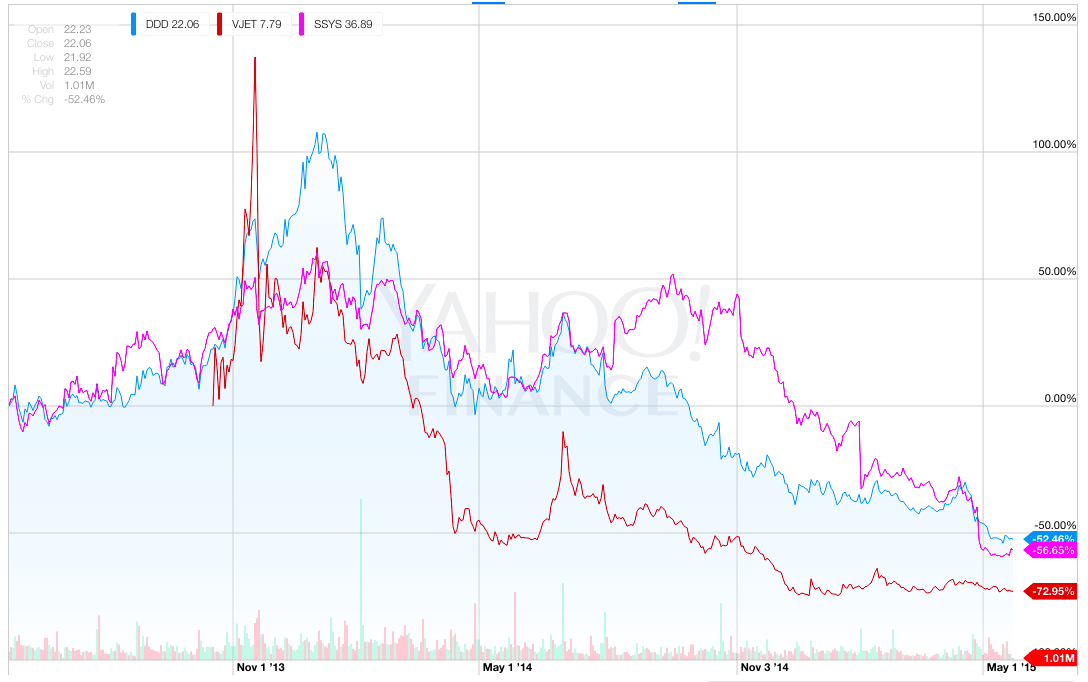If you’ve been reading these pages for any period of time, you’ll know a favorite quote of mine is an old Charlie Munger classic, “invert, always invert”. I use the concept often, looking to turn things upside down, in a non-literal way, to ensure a full perspective is gained in a manner that is as objective as possible.
There’s no better philosophy for us as long-term, income-oriented, fundamentally driven investors looking to build wealth the old fashioned way—no, not inheriting it. We do this through a consistent application of our craft that is underpinned by the ability to not be distracted by the “next shiny thing”.
The Next Shiny Thing...
You might not believe me, but I’ve been following the cohort of 3-D printing stocks since way back in the early to mid-2000s. And that’s not actually that long ago; Stratasys (SSYS), one of the publicly traded companies in the space, has been trading on the Nasdaq since way back in 1994, five years after being founded.
(Brief aside on the origins of Stratasys: In the words of their Wikipedia page contributor, “The idea for the technology came to (S. Scott) Crump in 1988 when he decided to make a toy frog for his young daughter using a glue gun loaded with a mixture of polyethylene and candle wax. He thought of creating the shape layer by layer and of a way to automate the process.”
But you might be asking yourself, why is a fundamental, dividend-oriented investor, a through and through price and value guy, looking at 3-D printing stocks?
Invert Always Invert

Jesse Livemore: Understand Thy Self
There was a pithy Q&A piece recently in the NYT where Andrew Ross Sorkin asked Bill Gross a few questions. In one of his answers Gross pulled out a time tested Jesse Livermore reference, which gets to how important the psychology of investing is — not so much everyone else’s psychology, but your own. Paraphrasing Livermore, Gross noted, “the most important thing in investing was to know yourself — your weaknesses, your flaws and your strengths.”
Here’s what I’ve found out about myself, I’m a very lousy market timer. I’m not a growth stock guy. I’m not a ’what’s got the most momentum behind it and let’s trade in and out and make some money on the stock, guy". I’ve looked at the 3-D printing business for the past 10 years trying to figure out the “there… there”. When the group ran up considerably in 2012 and 2013, I just didn’t get it. Why? How was it that 3D systems, for example, was a $90 stock in late 2013?
The short answer is: it wasn’t—longer term at least. I need reminders of the fact that I won’t be able to time the entry and exits of stocks or cohorts of stocks like this and consistently make money. I need to leave that for others, as I am sure there are many a-person who made quite a bit of money on these companies.
There wasn’t any there there; the hype was overblown and the valuation absurd for the underlying economics of the business. The stock’s price reflected unrelenting optimism about the industry and businesses potential, but it lacked substance.
The Antithesis of Dividend Investing
The point, of course, is that when we invert our “boring”, “time-tested” strategy of looking for companies with strong fundamentals, including solid management teams, track records of long term, diversified product success and a history and adherence to returning at least a healthy level of returning capital to shareholders via consistent dividends, we see things like the 3-D printer fad. Chasing growth, knowingly over-paying on valuation in the spirit of momentum and betting on our ability to trade out of the stock before an inevitable crash. That ain’t us. That ain’t me. If you’re reading this, that almost certainly ain’t you. As long-term investors I choose to believe we sleep better as we rarely mull over the shoulda, woulda, coulda’s of a missed entry or exit of a shiny new stock.
Know thyself — a Socratic philosophy reinterpreted by Jesse Livermore for smart investing. Well played Mr. Livermore, well played.
During this Memorial Day long weekend we encourage everyone to acknowledge the holiday’s importance and recognize the brave men and women who have served the United States in the name of ensuring it’s independence and freedom. Enjoy the weekend with friends and family, but please don’t gloss over the underpinnings of why Monday is a national holiday.
Talk to you next week!





